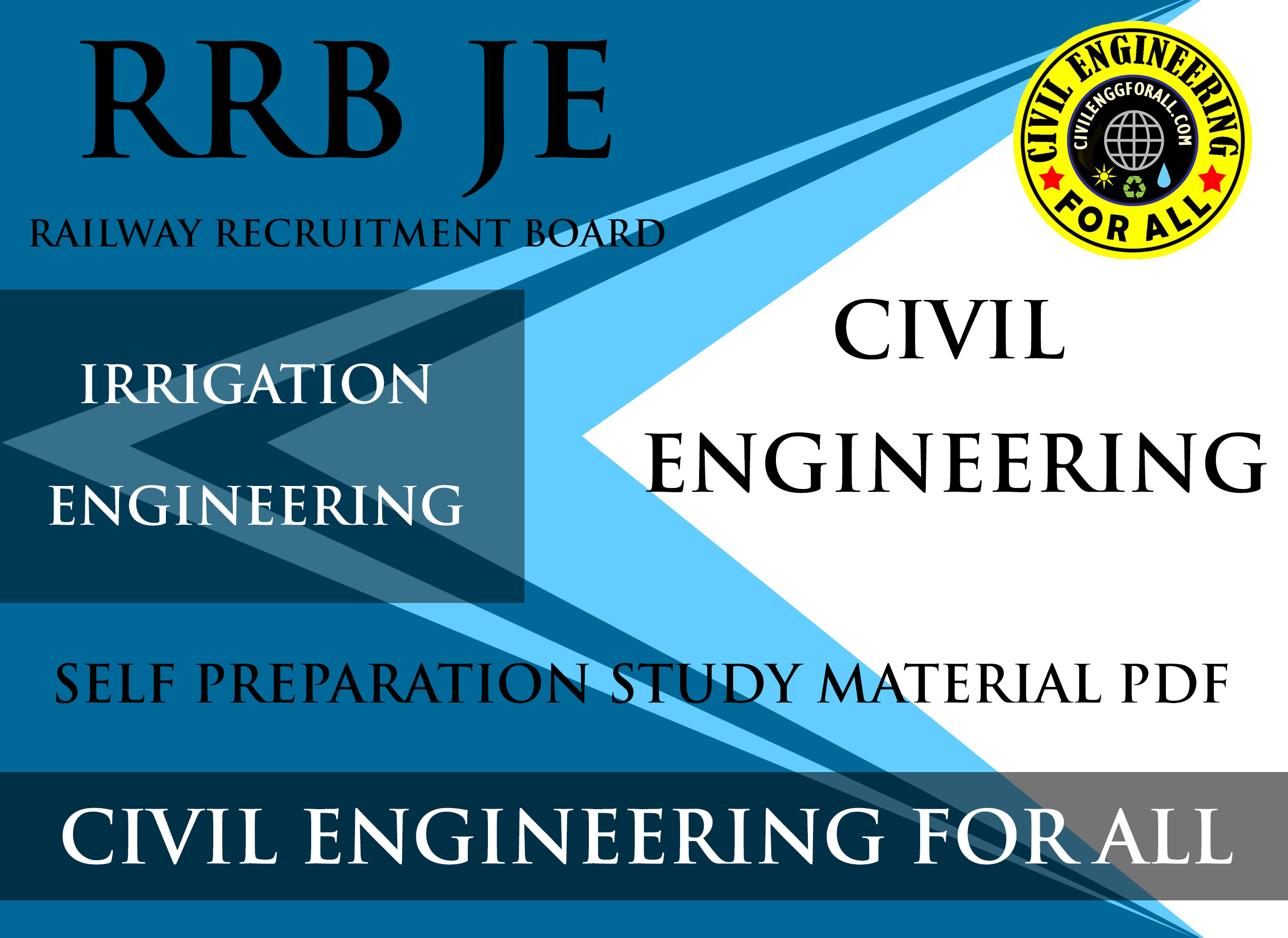

Table of Contents
CONTENTS
- INTRODUCTION TO IRRIGATION ENGINEERING
- TYPES OF IRRIGATIONS
- TECHNIQUES OF WATER DISTRIBUTION
- DELTA AND DUTY OF CROP
- FACTORS EFFECTING DUTY
- SOIL-MOISTURE-IRRIGATION RELATIONSHIP
- THEORY OF CONSUMPTIVE USE
- CANAL IRRIGATION
- DESIGN OF CANALS
- KENNEDY’S THEORY
- LACEY’S THEORY
- LINING OF CANALS
- GRAVITY DAMS ANALYSIS
- TYPES OF DAMS
- FORCES ACTING ON THE DAMS
- MODES OF FAILURE OF DAMS
- WATER LAGGING AND DRAINAGE DESIGN
- HYDROLOGY
- MEASUREMENT OF RAINFALL
- SNOWFALL
- ESTIMATION OF MISSING RAINFALL
- HYDROGRAPHS
- WELLS
- WEIR AND BARRAGE
- FLOOD CONTROL
- WATERSHED MANAGEMENT
- LAND RECLAMATION

INTRODUCTION TO IRRIGATION ENGINEERING
Irrigation may be defined as the science of artificial watering of the land in accordance with the crop required throughout the crop period, for full nourishment of the crop. Different crops will have different water requirements and the same crop may have different water requirements at different places of the same country, depending upon the variations in climate, type of soil, method of cultivation and useful annual rainfall etc.
IRRIGATION ENGINEERING IES MASTER GATE STUDY MATERIAL : CLICK HERE
ADVANTAGES OF IRRIGATION:
- Increase in food production.
- Ensuring optimum growth and yield.
- Elimination of mixed cropping.
- Generation of hydroelectric power.
- Improving domestic water supply.
- Inland navigation.
- Afforestation

DISADVANTAGES OF IRRIGATION
- Over Irrigation may cause, water logging which reduces crop yield.
- Irrigation may lead to creation of environmental conditions, which are favourable for outbreak of disease like-Malaria and Dengue.
- Irrigation may lead to seepage of nitrate into the ground water table causing a fall in soil fertility.
TYPES OF IRRIGATION

- FLOW IRRIGATION: When the water is available at a higher level and it is supplied to lower level under the effect of gravity, it is called flow irrigation.
- LIFT IRRIGATION: If the water is lifted up by some mechanical or manuals means, such as by pumps, etc and then supplied for irrigation, it is called lift irrigation.
- PERENNIAL IRRIGATION: In this system of irrigation, there is constant and continuous water supplies to the crops in accordance with the requirements of the crop throughout the crop period.
- FLOOD IRRIGATION: In this method of irrigation, soil is kept submerged and flooded with water, so as to cause thorough saturation of the field.
- NATURAL SUB-SURFACE IRRIGATION: Leakage water from channels etc, goes underground and during passage through the sub-soil, it may irrigate crops by capillarity. This water is called capillary water.
- ARTIFICIAL SUB-SURFACE IRRIGATION: When a system of open-joined drains is artificially laid below the soil, so as to supply, water through the crops by capillarity, then it is known as artificial surface irrigation.
IRRIGATION ENGINEERING ACE GATE STUDY MATERIAL : CLICK HERE
TECHNIQUES OF WATER DISTRIBUTION IN THE FIELD
FREE FLOODING
- This is also called ordinary flooding or wild flooding, because the flow of water is not controlled.
- This method is suitable for, close growing Crops.
- The water application efficiency of this method is low.
- This method is suitable for irregular topography.
- This method may be used on rolling land (topography irregular) where border, checks basins and furrows are not feasible.

BORDER FLOODING
- In this method, the field is divided into a number of strips, separated by low leeves called borders.
- The land area is confined between, 10-20 m width and having a length of 100-400 m. f: Infilteration Capacity of soil (depth/unit time). y: Depth of water flowing through strip. Q: Supply of water in main ditch.
- Note: This method of irrigation is very common in India. Shorters and narrower strips are found to be more efficient. To prevent water from concentration on either side of the border, the land should be levelled perpendicular to the water flow.
CHECK FLOODING
- This is the modified form of ordinary flooding, in which water is controlled by sorrounding the check area with low and flat leeves. These leeves are connected with cross leeves at convenient place as shown in fig.
- Note: This method is suitable for low permeable as well as high permeable soils.

BASIN FLOODING
This method is a special type of check flooding and is specifically adopted for clard trees or orchard tree.

IRRIGATION ENGINEERING MADE EASY GATE STUDY MATERIAL : CLICK HERE
FURROW IRRIGATION:
- Furrows are narrow drains which are excavated between rows of plants and carrying irrigation water through them.
- In this method of irrigation, only 20-50% of the field area is wetted and hence evaporation loses are considerably reduced.
- Furrows vary in depth from 8 to 30 cm, and may be as much as 400 metres long.
SPRINKLER IRRIGATION
In this method of irrigation, water is applied through a network of pipes and pumps. In this method, water is made available in the form of spray.
ADVANTAGES OF SPRINKLER IRRIGATION;
- When topography is irregular.
- When water table is high.
- When soil is less permeable.
- When water is not easily available.
- Where seepage loss is more.
- When number of labours have to be reduced.
- When fertilizers and insecticides have to be mixed with water.
- Contributes to water conservation as water loss because of evaporation is reduced.
IRRIGATION ENGINEERING ACE GATE NOTES : CLICK HERE
DISADVANTAGES OF SPRINKLER IRRIGATION
- Initial installation cost is high.
- Technical man power is required.
- It is not suitable for heavy irrigation for e.g. Rice.
DRIP IRRIGATION: (Trickling Irrigation)
- This is also called trickle irrigation.
- In this method, water is directly applied to the root zone of the plant using drip nozzles.
- Evaporation and percolation loses are considerably reduced in this method of irrigation.
- This method cannot be used, when heavy irrigation is required.
Delta of a Crop
The summation of the total water depth, supplied during, base period of a crop for its full growth, represents the total quantity of water required by the crop for its full nourishment. This total water depth (in cm) required by a crop to come to maturity is called its (delta).
Duty of water
It is defined as the number of hectares of field irrigated for full growth of a given crop by supply of 1 m3/s of water continuously during the entire base period of that crop.
IRRIGATION ENGINEERING STUDY MATERIAL FOR RRB JE PDF CIVILENGGFORALL
DOWNLOAD LINK : CLICK HERE
PASSWORD : CivilEnggForAll
OTHER USEFUL BOOKS
- BUILDING MATERIALS – MOCK TEST 1 (QUICK)
- TELANGANA STATE PUBLIC SERVICE COMMISSION – ASSISTANT ENGINEER 2023 – TSPSC AE 2023 CIVIL ENGINEERING EXAM SOLVED PAPER WITH EXPLANATIONS PDF FREE DOWNLOAD
- SSC JE 2023 CIVIL ENGINEERING (CPWD/CWC/MES) EXAM SOLVED PAPER PDF FREE DOWNLOAD
- BIHAR PUBLIC SERVICE COMMISSION ASSISTANT ENGINEER (BPSC AE) 2022 CIVIL ENGINEERING EXAM SOLVED PAPER WITH EXPLANATIONS PDF
- NHPC (NATIONAL HYDROELECTIC POWER CORPORATION) JUNIOR ENGINEER NHPC JE 2022 CIVIL ENGINEERING EXAM SOLVED PAPER PDF FREE DOWNLOAD

Leave a Reply